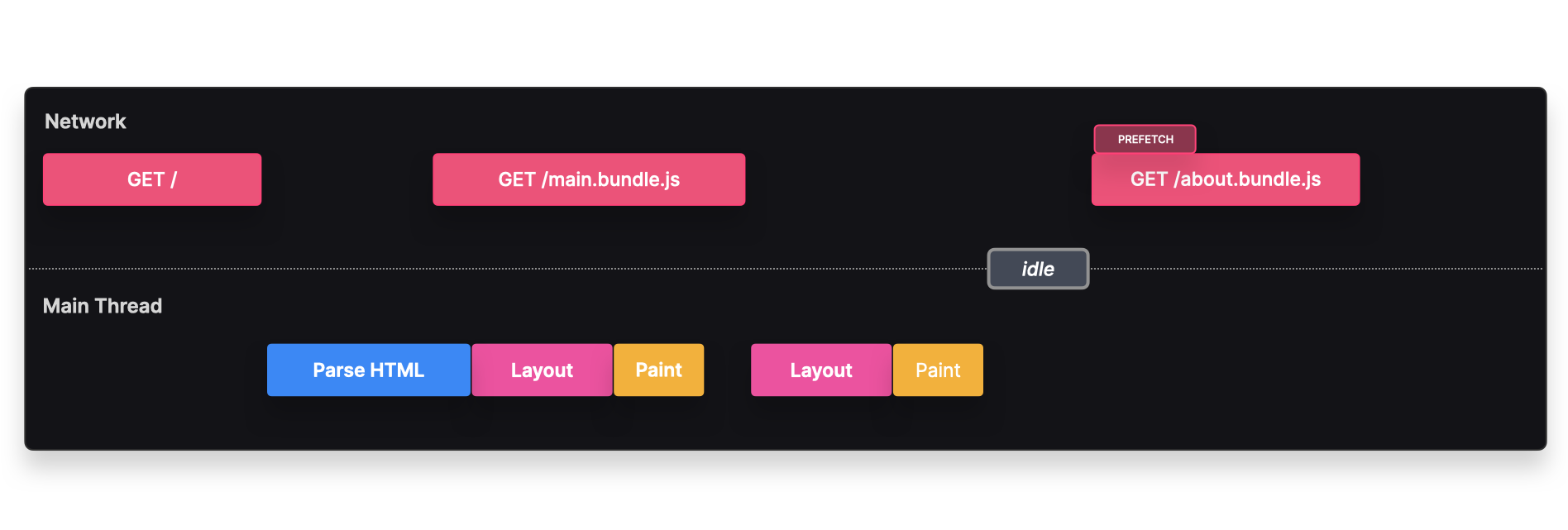Browser Hints
Use hints to inform the browser about (optionally) critical resources
Prefetch
Fetch and cache resources that may be requested some time soon
Overview
The prefetch browser hint can be used to fetch resources that may be needed some time soon, but not immediately on the initial load. This can be the case on subsequent requests or page navigations that a user is likely to make.
A prefetched resource is fetched when the browser is idle and has calculated that it's got enough bandwidth, after which it caches the prefetched resource. When the client actually needs the resource, it can easily get it from cache instead of having to make a request to the server.

For example if we use route-based splitting, and we know that most users will navigate to the /about route, we can prefetch this route to get a faster navigation, resulting in a better UX.
Instead of waiting for a user interaction to fetch the about.bundle.js bundle, the browser prefetched this resource when it was idle. Once the user actually navigates to the /about page, the bundle can quickly load from cache instead of making a request to the server.
Implementation
We can prefetch a resource by explicitly adding it to the head of the html document.
<link rel="prefetch" href="./about.bundle.js" />If you're using Webpack, you can prefetch it dynamically by using the /* webpackPrefetch: true */ magic comment.
const About = lazy(() => import(/* webpackPrefetch: true */ "./about"));Tradeoffs
Loading time: The browser can quickly load and render the component from cache, instead of having to make a request to the server.
Unnecessary: If the user ended up never navigating to the About
route, we unnecessarily loaded the resource, which could negatively affect the
app's performance and be costly to the user.
Preload
Inform the browser of critical resources before they are discovered
Overview
The preload browser hint can be used to fetch resources that are critical to the current navigation, such as fonts or images are instantly (not longer than 3 seconds after the initial load) visible on a landing page.

With prefetch, the browser would only actually prefetch the resource if the conditions were good enough to not negatively affect the user experience. Unlike a prefetch, a preloaded resource gets fetched no matter what.
For example, if we wanted to show the SearchFlyout instantly on the landing page, we can preload this resource to make sure the user won't have to wait too long before this resource is available.
The search-flyout.bundle.js bundle is fetched in parallel with the main.bundle.js. When the client actually needs to render the resource, which happens soon after the initial load, it can quickly retrieve it from the HTTP cache.
Implementation
We can preload a resource by explicitly adding it to the head of the html document.
<link rel="preload" href="./search-flyout.bundle.js" />If you're using Webpack, you can preload it dynamically by using the /* webpackPreload: true */ magic comment.
const SearchFlyout = lazy(() =>
import(/* webpackPreload: true */ "./SearchFlyout")
);Tradeoffs
Loading time: The browser can quickly load and render the component from cache, instead of having to make a request to the server.
Layout shift: Preloading styles, fonts and images can reduce layout shift.
Performance: Since preloaded assets will get fetched no matter what, it's important to only preload resources that are actually instantly necessary. In most cases, it's worth either prefetching the resource, or if it's JavaScript, using a script with an async or defer attribute.
<link href="./script" rel="preload" />
<script rel="defer" src="./script" />